This article was initially published with a video. We've since removed the video from our site because we feel it does not meet our editorial standards.╠ř║┌┴¤│ď╣¤═°╠řapologizes for the error. ╠ř╠ř
At the moment, there are five main types of water╠řtreatment devices, all of which we recently tested at MSRÔÇÖs water lab in the companyÔÇÖs╠řheadquarters in Seattle, Washington. This week,╠řwe break down╠řthe╠řtechnologies used in each. Next, weÔÇÖll follow up with reviews.
Also, before we move on, a╠řquick note about protozoa, bacteria, and virusesÔÇöthe bugs these devices are designed to catch. Protozoa are the largest and easiest to filter out, but theyÔÇÖre tough to kill with chemicals. Bacteria are smaller than protozoa, but most of the devices on this list can still handle them. Viruses, like norovirus, are the smallest of the bunch and can sneak through most of the filters on this list. But fear not:╠řViruses are mostly a concern if youÔÇÖre traveling internationally. (If you are leaving the country, check out the MSR Guardian below, under Ultrapurifier, or the chemical treatments.)
░ń│ˇ▒│żż▒│Ž▓╣▒˘╠ř
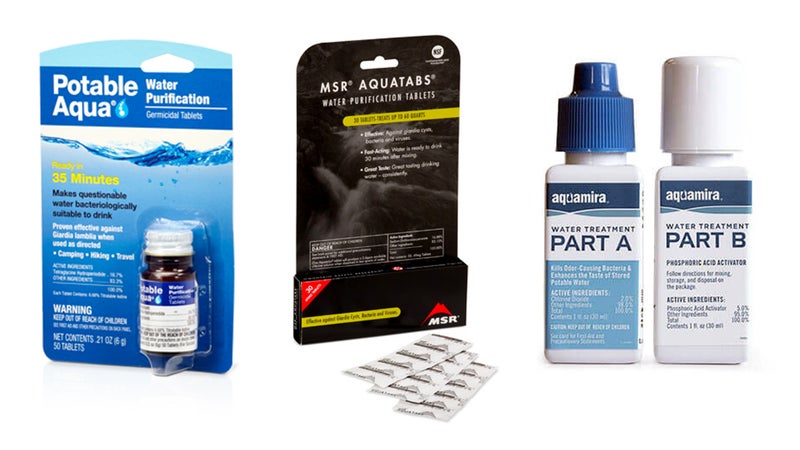
Examples: , ,
How It╠řWorks: Chemicals kill bacteria, viruses, and sometimes protozoa. (Note:╠řChemical treatments, including the ones above, are tested and controlled by the EPA. The other devices we tested╠řare not.)
Strengths: Ease of use and portability
Weaknesses:╠ř
- ThereÔÇÖs a finite amount of bug-killing agent. If you donÔÇÖt use enough, there might be leftover bugs. And because the╠řchemicals attack everything in their path, including bits of leaf debris or pine needles, they get used up quickly in dirty water.╠ř
- TheyÔÇÖll make you sick if you use too much, and itÔÇÖs not safe to consume large amounts for an extended period of time.╠ř
- ProtozoaÔÇöparticularly cryptosporidium,╠řwhich is often present in U.S.╠řwaterwaysÔÇöare highly resistant to chemical treatments. Some chemical treatments, like Potable Aqua Chlorine Dioxide, can kill cryptosporidium╠řbut only after a four-hour wait. For comparison, it takes just 30 minutes for the pills to kill viruses and bacteria.
Bottom Line: Travel with chemical pills as a backup,╠řor use them in conjunction with other types of water╠řtreatment devices. TheyÔÇÖre also great when youÔÇÖre traveling somewhere with virus-infested water.
Ultraviolet
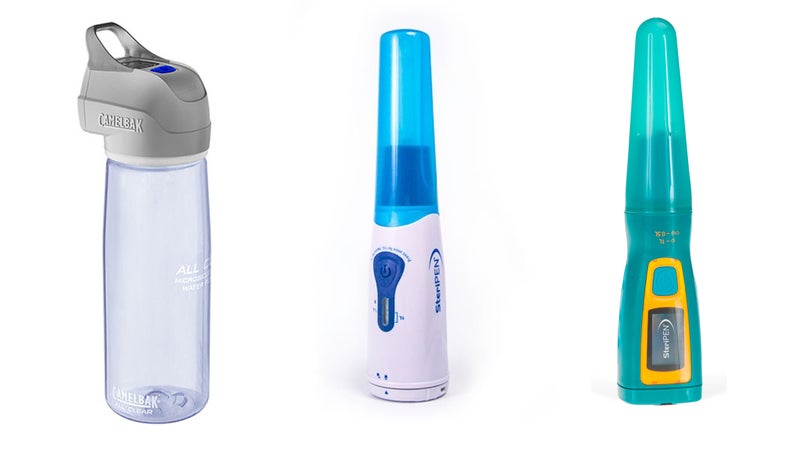
Examples: , SteriPen ╠řor
How It╠řWorks: These devices use ultraviolet rays to kill bugs.╠ř
Strengths: UV light is powerful╠řand will kill bacteria, protozoa, and even viruses if used correctly.
Weaknesses:╠ř
- To be effective, the UV rays need to hit the bacteria, virus, or protozoa head-on. This means UV filters donÔÇÖt work well in silty water.╠ř
- ThereÔÇÖs potential for user error. You need to agitate the water youÔÇÖre purifying so the rays hit the entire sample. This can be hard to do with some devices.
Bottom Line: Make sure you prefilter or use clear water with this treatment. Follow the directions closely.
Adsorptive
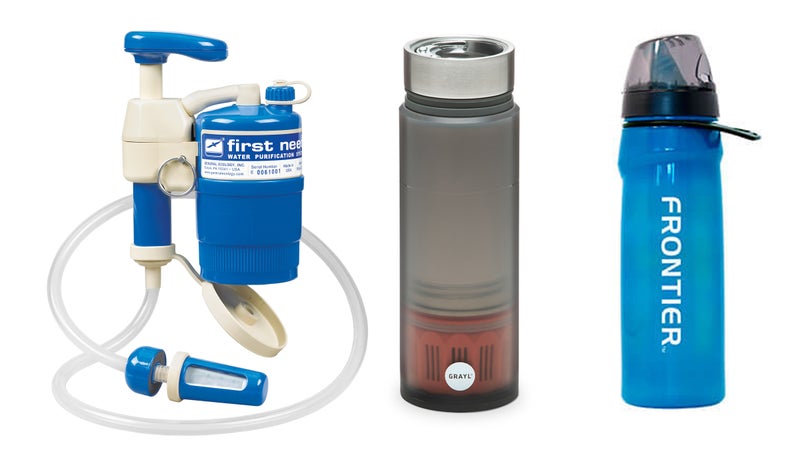
Examples: , ,
How It╠řWorks: An adsorptive is like a tiny magnet that attracts and captures objects. As you push it through water, it grabs bugs, particulates, and chemicals,╠řleaving clean water behind.
Strengths: When used correctly, an adsorptive filter removes even the tiniest impurities because the magnetic sites attract bugs of all sizes. Adsorptive filters not only remove bacteria, protozoa, and viruses, but also clean out chemicalsÔÇöthink pesticides and fertilizersÔÇöwhich are tiny and difficult to catch with other filter systems.
Weaknesses:╠ř
- There are a limited number of attractive sites in an adsorptive device, and they stop working once theyÔÇÖre saturated. ThereÔÇÖs also no way to know when the magnetÔÇÖs full.
- Silty╠řwater is a problem because particulates fill the spots instead of bugs.╠ř
- If you move water through an adsorptive filter too quickly, the magnet╠řwonÔÇÖt have enough time to grab the bugs.
Bottom Line: Because it removes chemicals, an adsorptive filter gets rid of bad tastes and odors associated with╠řpollutants. It will clear out all the bugs as well, but since you canÔÇÖt tell when itÔÇÖs full and stops working, this type of water╠řtreatment device is probably best used in conjunction with another type of treatment device.
Microfilter
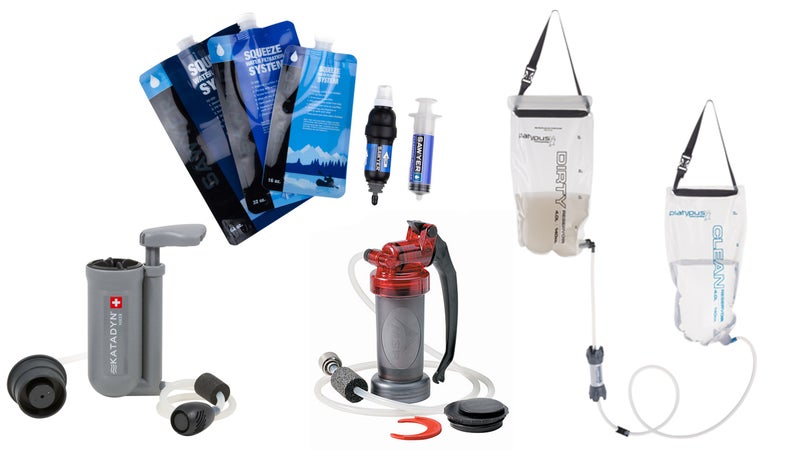
Examples: , , ,
How It╠řWorks: A microfilter works a bit like a colander, but instead of catching pasta, it filters out protozoa and bacteria. ╠ř
Strengths: The holes are small enough to catch bacteria and protozoaÔÇöbut╠řnot viruses. The filter will clog, but you can tell when that happens so you know to throw it away and replace it with a new one.╠ř
Weaknesses:
- The holes are not small enough to get rid of viruses,╠řjust bacteria and protozoa. If youÔÇÖre in a place that has a lot of viruses,╠řyouÔÇÖll want to back up your filtration with a chemical tablet or go for an ultrafilter (listed below).╠ř
Bottom Line: Reliable and a great go-to for backpacking in the United╠řStates.
Ultrapurifier
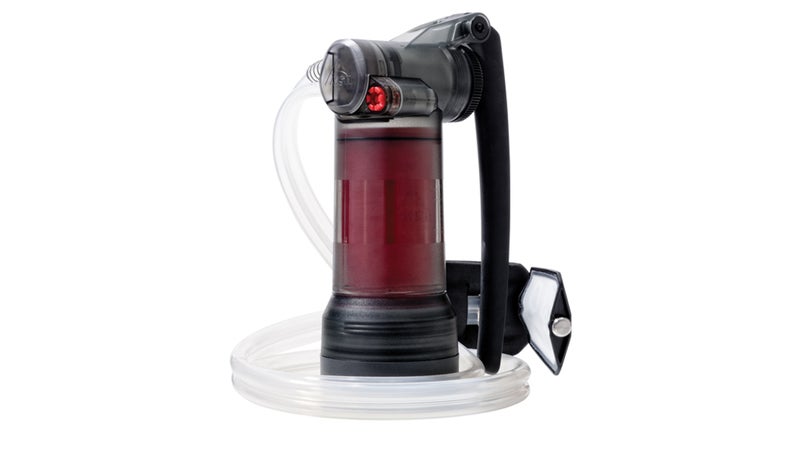
Example: MSR Guardian (available January╠ř1, 2016)╠ř
How It╠řWorks: It uses the╠řsame general principle as a microfilter, but the pores are roughly ten times smaller, so they also filter out viruses.
Strengths: It gets rid of protozoa, bacteria, and viruses, which makes the purifier╠řideal for international travel. It also alerts you when the filter╠řneeds to be replaced.╠ř
Weaknesses:╠ř
- It wonÔÇÖt catch really╠řsmall particles like chemicals or fertilizers.╠ř
- ItÔÇÖs expensive at $350.
Bottom Line: If you have $350╠řand do a lot of international travel, this is what you want. Yes, itÔÇÖs up to╠řthree times more expensive than a normal filter (and╠ř30 times more expensive than chemical tablets),╠řbut itÔÇÖs the safest, most foolproof╠řwater purification╠řtechnology on the market. Anyone whoÔÇÖs had norovirus or giardia╠řwill tell you that $350 is well worth that peace of mind.


